Last-Minute NYC Holiday Gift Guide 🎁
We’ve created a holiday gift guide with presents for the intrepid New Yorker that should arrive just in time—


New York City’s straphangers may like to complain about the state of the subway or its unreliable service, but in the digital age, we’re enjoying many technological amenities such as train arrival clocks, air conditioned cars and underground Wi-Fi. Yet, there are many quirky and fun features from the old subway system that we wished the MTA would bring back. From straphangers to woven seats, here’s a round up of nostalgic vintage features that were once common sights.
For more subway history and fun facts, make sure to also join us on a future Underground Tour of the NYC Subway:

Ride through the oldest stations, uncover hidden art, and more!
As part of a campaign to clean up the subway system in the 1960s the NYC Transit Authority (before it was incorporated into the MTA) introduced a “bar car” in 1962 on a subway running between Times Square and South Ferry. The bar car gave straphangers a taste of first class luxury with plush carpeting, draped curtains and pastel lighting.
As riders made their way downtown or back up to Times Square they could enjoy a glass of champagne and a pretzel or bagel. Though the bar car was only a one time publicity stunt, we think that brining it back would add a touch of class to our commutes. Read more about the “bar car” here.
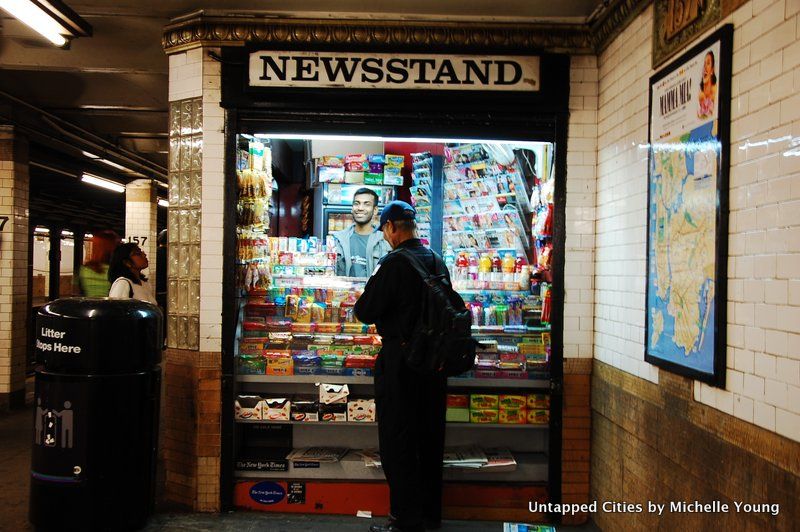
Although pretzels were first brought to America in the 18th century by German settlers via Pennsylvania, the salty twisted treats have become a staple of the New York City street food scene. Since the late 19th century, when street vendors lined the streets of Manhattan, pretzels have served as a steadfast snack for the busy New Yorker.
Today, it is easy to find a soft pretzel out on streets and many subway stops do have food vendors at the station — like the Turnstyle Underground Market at Columbus Circle — but the most convenient way to grab this classic snack, and not miss your train, would be to have a pretzel vendor right on the subway platform. In the 1960s, commuters at the Union Square station were able to do just that (see photo here). In recent years, the city has been cracking down on subway food vendors, and in 2017, the MTA Chief even suggested banning food on the subway. (But we say bring back the platform pretzels!)
In the era before cell-phones, a newspaper and cigarette were necessities for subway commuters. The man who made newspapers and other conveniences like gum easily available to the rail riding public was Artemis Ward. Ward noticed that time strapped commuters rushed past newspaper carts at subway station entrances, but had more “compulsory leisure time” once they actually got to the platform and had to wait for their trains. In 1889, Ward acquired a vending permit for the entire New York Transit system, which was above ground at the time. When the underground subway system boomed in the early 1900s, Ward’s exclusive contract and advertising rights made him a fortune. In addition to newspaper and magazine vendors, New York City subway platforms hosted vending machines that dispensed soda, coffee, candy, gum, and horoscopes. Commuters could use their time waiting on the platform to see into their future or measure their weight for as little as a five cents. Vintage photographs of the subway show gum and cigarette dispensers inside columns on subway platforms.
In 2013, L’Oreal brought vending machines back, for a moment, when the company put high-tech cosmetic dispensing machines at the 42nd Street-Bryant Park station. A wish list compiled by our office at Untapped Cities includes vending machines that dispense hand sanitizer, healthy snacks, Tide-pens and cupcakes.
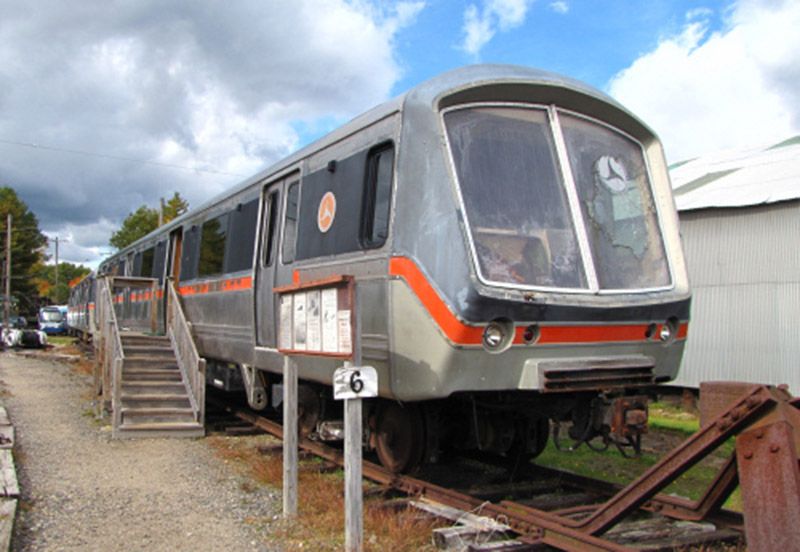
Riders on the A, D, E and N lines may have been confused by a certain subway train that pulled into the platform in 1974. The SOAC or “State-of-the-Art Car” was a futuristic looking vehicle with a large front windshield and sleek stainless steel body with comfortably cushioned seats and some tables inside, a stark contrast to the graffiti covered cars commuters were used to riding. In a brochure from the urban Mass Transportation Administration, the car was advertised as a “people-car” offering the most advanced “creature comforts” such as climate control, noise reduction, and a faster safer ride. The SOAC, which was designed and built by the St. Louis Car Company, was evaluated through public use in New York, Boston, Cleveland, Chicago and Philadelphia. Although the cars were well received, the Transportation Administration’s goal of implementing a universal transit car design failed and the St. Louis Car Company closed in 1974. The SOAC now sits on display at the Seashore Trolley Museum in Kennebunkport, Maine.
Since the introduction of the SOAC, transit authorities still take into account feedback from commuters. Over the years, there have been many technological improvements made to New York City subway cars, and more is to come soon. This includes open gangways, wider doors, more real-time digital displays and an overall, modern design, though we wouldn’t mind the return of old-fashioned cushioned seats and tables.
See photos from the open gangway model subway car that will be coming to the NYC system.
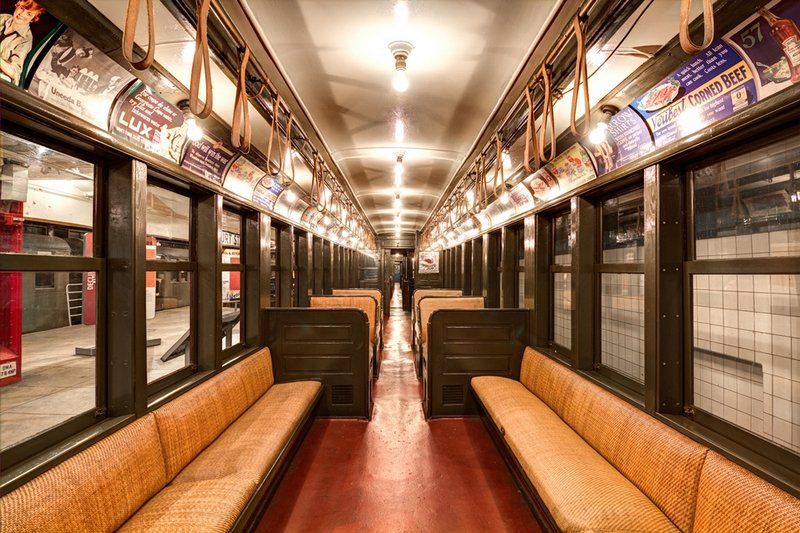 Vintage subway car at the New York Transit Museum with fabric “straphangers”. Photo courtesy New York Transit Museum.
Vintage subway car at the New York Transit Museum with fabric “straphangers”. Photo courtesy New York Transit Museum.
The term straphangers may be confusing to modern day riders, after all, there are no straps on the subway. However, the first standing subway car riders held onto canvas straps to stabilize themselves. Over time, the canvas straps were replaced by metal “grab holds” and eventually replaced entirely by plain metal bars.
No solution keeps the spread of germs away, but individual straps at least eliminate the awkwardness of accidentally touching a stranger’s hand, or having to fight for a spot on a pole to hold onto. Those who want to relive the strap-hanging experience can check out the entire level of vintage subway trains at the New York Transit Museum, ride on a nostalgia train, or purchase metal subway grab holds from the Transit Museum store.
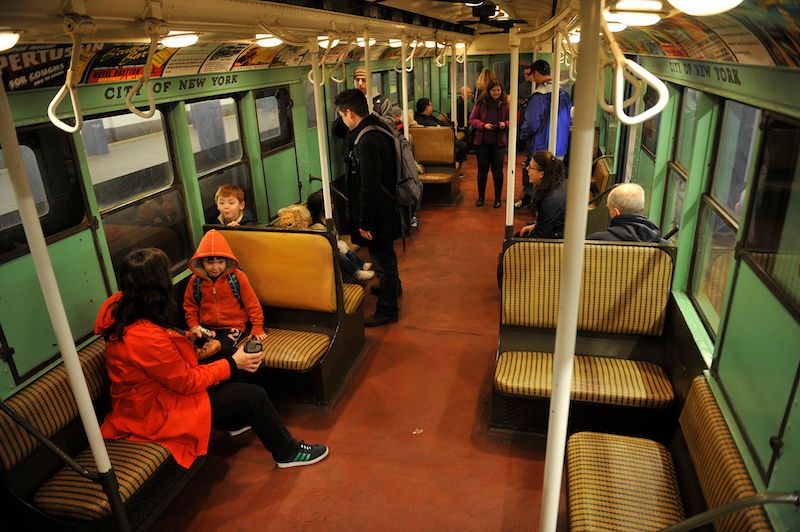
Even if you’re lucky enough to squeeze into a seat on the subway, the cold, hard communal benches don’t offer much in the way of comfort. In the early days of the New York City subway system, commuters sat comfortably on spring cushioned, rattan-covered benches. The woven wicker-like seats added a homey look to vintage subway cars, but did have a drawback.
New York Transit Museum educator, James Giovan, told amNewYork that when the rattan covered benches became worn, springs would poke out and get stuck on commuters’ clothing, sometimes even tearing a hole in their garments. Since some proposed subway cars have no seats at all, we’ll take our chances (for the sake of the vintage aesthetic). In any case, you can still see and experience these seats by hopping in a Holiday Nostalgia Train, which makes an appearance every holiday season or check out the trains on display at the Transit Museum.
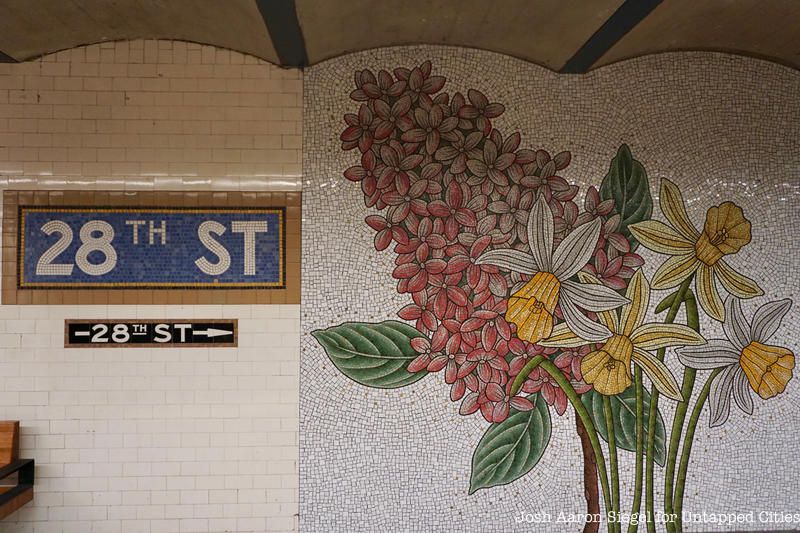
Classic white subway tile is having a moment in interior design, but our focus is on the colorful mosaics that adorn the walls of New York City subway platforms. During the construction of the subway system, many architects and artists were commissioned to design ceramic flourishes for signage. The original intent of the decorative signs was to announce the name of the stop and to help non-English speakers, who couldn’t read the words on signs, orient themselves based on the artwork. Most original Arts and Crafts/Beaux Arts-style ceramic designs were created by Heins & LaFarge (1901–1907) and Squire Vickers (1906–1942).
While many new subway stations, like the World Trade Center Transportation Hub and the Second Ave subway, have a streamlined and modern aesthetic, we are happy that the tradition of showcasing art in the subway is being upheld, and that new stations continue to feature artwork that incorporate the mosaic technique.
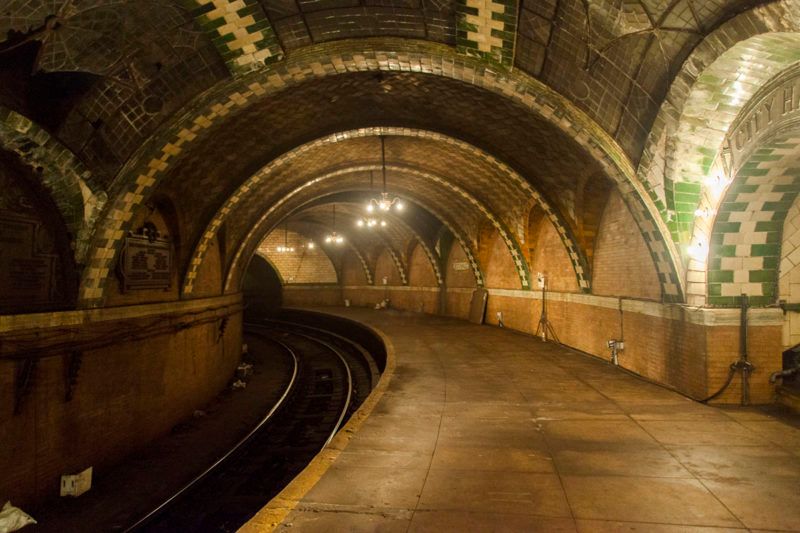
The Interborough Rapid Transit Company built the now abandoned City Hall Subway Station as part of the Manhattan Main Line, the first line of the New York City Subway, which ran from City Hall to 145th Street. City Hall Station, which marked the beginning of the New York City subway when it opened on October 27, 1904, was designed by Rafael Guastavino, who also did the tiling in Grand Central’s whispering gallery as well as work in many other New York City locations.
No subway station can rival the grandeur of the City Hall Station, even in its decomissioned state. It features architectural wonders, such as tiled arches, brass chandeliers, and skylights. However, due to its curved platform, which was not able to accommodate newer, longer cars, the station was ultimately closed in 1945. Today, new subway stations and transit hub renovations showcase exciting new sleek and modern designs, but we’re nostalgic for the Gilded-Age extravagance of City Hall Station. Also read up on 10 Secrets of NYC’s Abandoned City Hall Subway Station and see photos inside.

Every time the MTA brings vintage subway cars out for a nostalgic ride, one of the details most riders notice are the vintage subway ads. The often quirky, sometimes antiquated, and always visually appealing ads offer a glimpse into the habits and customs of the past. Since the boom of advertising in the 1950s and 60s, the exponential growth of advertising has continued unabated while advertisers seek space wherever they can, especially on the subway, to get their ads in front of our our eyes.
While many subway ads are now digitized, which can allow for more creativity in advertisers’ use of video elements, we sometimes yearn for the simpler days of colorful and cartoony illustrated ads as well as similarly styled Subway Maps.

In 2016, the New York Transit Museum opened its exhibition, Transit Etiquette or: How I Learned To Stop Spitting and Step Aside in 25 Languages at its Gallery Annex at Grand Central Terminal. The exhibition featured over 100 years of posters from around the world calling on transit riders to refrain from littering, give up a seat to the elderly, and step aside for exiting passengers, among many other transit niceties.
The show was organized by “transit etiquette sin,” starting with “Be a Space Saver” and ending with “This is Your Train, Take Care of it,” and features transit etiquette artwork from Barcelona, Brussels, Chicago, London, Madrid, Philadelphia, Rio de Janeiro, Taipei, Tokyo, and of course New York City. One of the most remarkable observations is that behind the eye-catching graphics, the message is essentially the same throughout history and across languages. It seems that a) we haven’t learned to be more polite on our commutes through the generations and b) transit transgressions aren’t limited to any particular culture or geography.
But there are some signs of the times. Early commuters weren’t used to being confined in small places underground. So smoking and spitting were big problems
Today, riders of the New York City subway will see signs forbidding the use of hoverboards on the system, a gadget that was certainly not around half a century ago. But Todd Gilbert, the New York Transit Museum’s registrar, thinks there are more than a few parallels between the classic work of Jones and the MTA’s “Courtesy Counts” transit etiquette campaign. And if media coverage and internet chatter are any measure, “Courtesy Counts” has been a huge success. If the messages seem redundant (no noise, no litter, no space hogging, no door-blocking), well, that’s the point. Transit etiquette, and the lack thereof, is a universal language.

August Belmont Jr. Belmont Jr., founder of the Belmont Park racetrack and President of the Interborough Rapid Transit (IRT), the company that ran New York City’s first subway line, rode the rails in his own private car. Named The Mineola, Belmont’s custom made car was decked out with wood paneling, Tiffany glass panels, a kitchen galley, a servants call system, a toilet, electrical heating, a roll-top desk and a resting area. There were also convenient touches like match strikers placed throughout the car. Belmont and his guests would travel from the Hotel Belmont to his racetrack via a private track from Grand Central Terminal, and an agreement with the Long Island Railroad allowed Belmont to make transfers at Atlantic Yards to continue on to any destination along the Eastern seaboard. The Mineola is currently housed at the Shoreline Trolley Museum in Connecticut and is awaiting restoration.
A private subway car is the ultimate in commuter luxury. Untapped Cities’ private subway car would have the basic comforts Belmont had in his car like a clean bathroom, comfy seats, and a well stocked kitchen, but we would also add some modern day must-haves like strong Wi-Fii connection, a pull out bed for longer trips, and a bookshelf to share our latest reads.
Read about Untapped Cities’ trip to see “The Mineola”: Tracking Down August Belmont Jr.’s Private NYC Subway Car, The Mineola.
Next, check out 12 of NYC’s Lost Subway and Rail Lines and Experience the NYC Subway in 1949 with a Vintage Video.
Subscribe to our newsletter